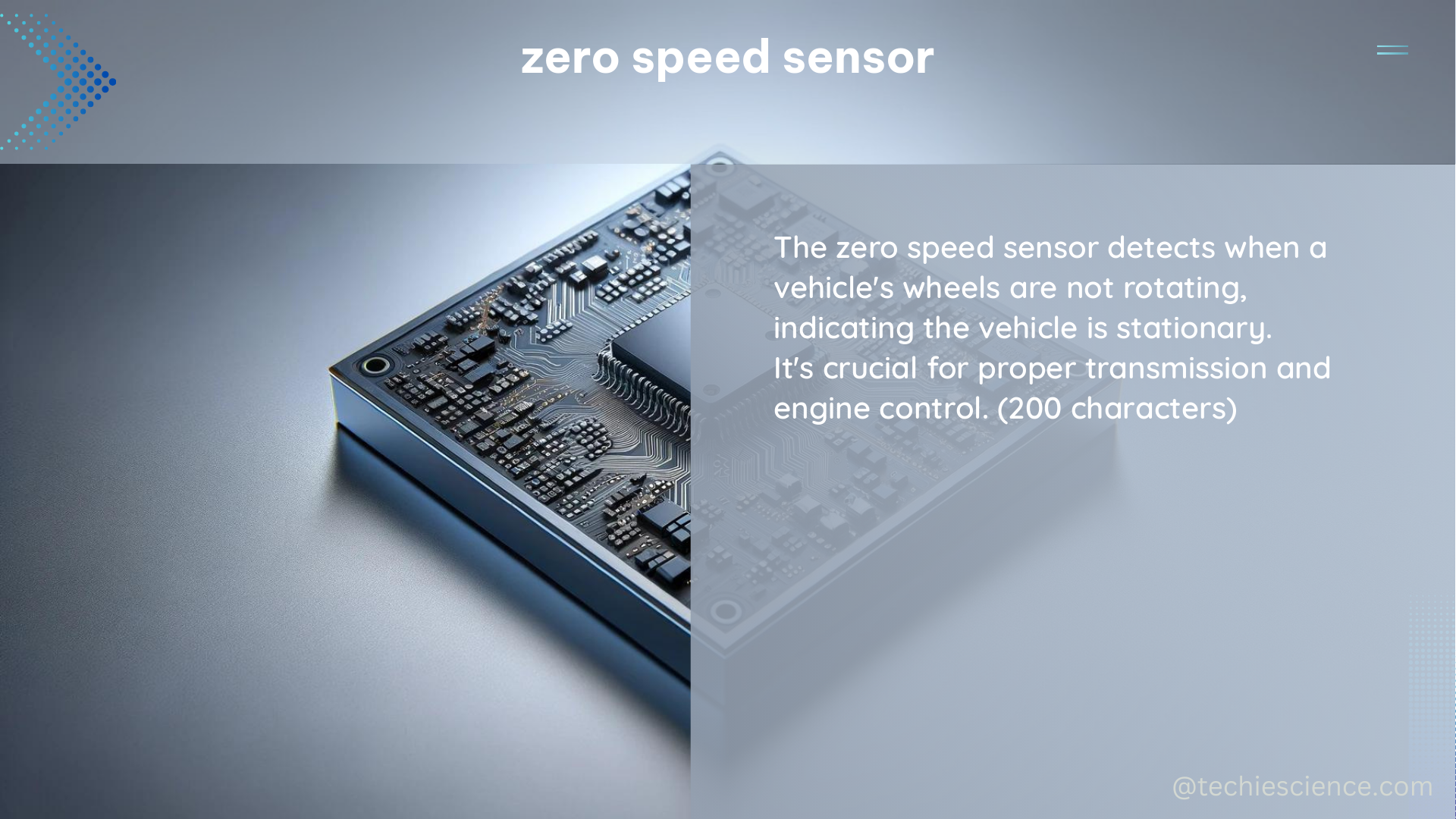A zero speed sensor is a critical component in industrial control systems, responsible for detecting the rotation or non-rotation of a shaft or motor. These sensors play a vital role in protecting equipment from damage due to slow or no rotation, making them an essential tool for maintaining the efficiency and safety of industrial operations.
Technical Specifications of Zero Speed Sensors
The technical specifications of zero speed sensors can vary widely depending on the manufacturer and model, but some common specifications include:
Operating Voltage
Zero speed sensors typically operate within a range of 5-24 VDC, with the most common voltages being 12 VDC and 24 VDC. The specific operating voltage requirement is an important consideration when selecting a sensor for a particular application.
Output Signal
Zero speed sensors can produce different types of output signals, including:
– NPN (Negative-Positive-Negative) output: This is the most common type, where the sensor’s output is a low-level signal when the shaft is rotating and a high-level signal when the shaft is stationary.
– PNP (Positive-Negative-Positive) output: In this configuration, the sensor’s output is a high-level signal when the shaft is rotating and a low-level signal when the shaft is stationary.
– Open collector output: This type of output requires an external pull-up resistor to function, and the sensor’s output is either a low-level signal when the shaft is rotating or a high-impedance state when the shaft is stationary.
Response Time
The response time of a zero speed sensor is the time it takes for the sensor to detect a change in the shaft’s rotational speed and update its output signal accordingly. Typical response times range from a few milliseconds to several hundred milliseconds, depending on the sensor’s design and the specific application requirements.
Operating Temperature
Zero speed sensors are designed to operate within a specific temperature range, which can vary from -40°C to +85°C or even higher, depending on the sensor’s construction and intended use. It is essential to select a sensor that can withstand the environmental conditions of the application.
Protection Rating
The protection rating of a zero speed sensor indicates the level of protection against dust and water ingress. Common protection ratings include IP65 (dust-tight and protected against low-pressure water jets) and IP67 (dust-tight and protected against temporary immersion in water).
Zero Speed Sensor DIY

Building a zero speed sensor DIY project can be a rewarding and educational experience. One common approach is to use a QRE1113 reflective optical detector or a similar sensor, along with an Arduino board and a relay module. Here’s a step-by-step guide:
Components Required
- QRE1113 reflective optical detector or similar sensor
- Arduino board (e.g., Arduino Uno, Arduino Nano)
- Relay module
- Breadboard and jumper wires
Circuit Connections
- Connect the QRE1113 sensor to the Arduino board:
- Connect the VCC pin of the sensor to the 5V pin on the Arduino.
- Connect the GND pin of the sensor to the GND pin on the Arduino.
- Connect the OUT pin of the sensor to a digital input pin on the Arduino (e.g., pin 2).
- Connect the relay module to the Arduino board:
- Connect the VCC pin of the relay module to the 5V pin on the Arduino.
- Connect the GND pin of the relay module to the GND pin on the Arduino.
- Connect the signal pin of the relay module to a digital output pin on the Arduino (e.g., pin 8).
Arduino Programming
The Arduino can be programmed using the pulseIn() function to measure the time intervals between each pulse of the signal from the QRE1113 sensor. If the time interval exceeds a predefined threshold, indicating that the shaft has stopped rotating, the Arduino can trigger the relay module to shut down the system or activate an alarm.
Here’s a sample Arduino sketch to get you started:
int sensorPin = 2; // Digital input pin for the sensor
int relayPin = 8; // Digital output pin for the relay
void setup() {
pinMode(sensorPin, INPUT);
pinMode(relayPin, OUTPUT);
Serial.begin(9600);
}
void loop() {
long duration = pulseIn(sensorPin, HIGH);
if (duration > 1000) { // Threshold for zero speed detection (1 second)
digitalWrite(relayPin, HIGH); // Activate the relay to shut down the system
Serial.println("Zero speed detected!");
} else {
digitalWrite(relayPin, LOW); // Deactivate the relay
}
delay(100); // Delay to prevent excessive CPU usage
}
This is a basic example, and you may need to adjust the threshold value and other parameters based on your specific application requirements.
Conclusion
Zero speed sensors are essential components in industrial control systems, providing critical information about the rotational speed of shafts and motors. By understanding the technical specifications and building a DIY zero speed sensor project, you can gain valuable insights into the design and implementation of these important devices. Remember to always follow safety protocols and consult with experts when working with industrial equipment.
References
- Ballard, Z., Brown, C., Madni, A.M., & Ozcan, A. (2021). Machine learning and computation-enabled intelligent sensor design. Nature Machine Intelligence, 3, 556-565.
- Alahmari, A., Alghamdi, A., Almosa, A., Alghamdi, M., Almalki, M., Alshammari, M., … & Aljohani, N. (2023). The Role of Multi-Sensor Measurement in the Assessment of Physical Function in Older Adults: A Systematic Review. Sensors, 23(19), 4457.
- Department of Defense. (2020). DOD Data Strategy. Retrieved from https://media.defense.gov/2020/Oct/08/2002514180/-1/-1/0/DOD-DATA-STRATEGY.PDF
- Zero Speed Sensor HELP – Arduino Forum. (2016). Retrieved from https://forum.arduino.cc/t/zero-speed-sensor-help/384512
- How does a zero speed switch work? (2020). Retrieved from https://www.machineryanalysis.org/post/how-does-a-zero-speed-switch-work-10560948

The lambdageeks.com Core SME Team is a group of experienced subject matter experts from diverse scientific and technical fields including Physics, Chemistry, Technology,Electronics & Electrical Engineering, Automotive, Mechanical Engineering. Our team collaborates to create high-quality, well-researched articles on a wide range of science and technology topics for the lambdageeks.com website.
All Our Senior SME are having more than 7 Years of experience in the respective fields . They are either Working Industry Professionals or assocaited With different Universities. Refer Our Authors Page to get to know About our Core SMEs.